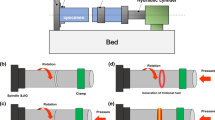Abstract
The grindability of Ti-based alloys was analyzed by considering the fracture behavior of individual alloys in response to the stress field of a grinding wheel. First, the stress field under a grinding wheel was computed by treating the grinding wheel as a cylindrical disk with a flat region acting on a flat substrate. The initiation and propagation of microcracks in the substrate was then examined on the basis of the contact stress field and one of two fracture criteria: (1) a critical stress criterion for the onset of cleavage crack initiation, and (2) a critical stress intensity factor criterion for the initiation and propagation of shear cracks. Grindability was computed as a function of grinding speed and microstructure for several Ti-based cast alloys containing α, α + β, or β microstructure with or without the intermetallic precipitates. Model predictions indicated that the grindability of Ti alloys increases with decreasing fracture toughness or tensile ductility. The theoretical results are compared against experimental data in the literature to elucidate the roles of microstructure in grindability. The comparison revealed that alloying addition that leads to the formation of brittle intermetallics enhances grindability by reducing fracture toughness, tensile ductility, and the resistance to crack initiation and propagation.
Similar content being viewed by others
References
T. Okabe, C. Ohkubo, I. Watanabe, O. Okuno, and Y. Takada: JOM, 1998, vol. 50 (9), pp. 24–29.
T. Okabe, M. Kikuchi, C. Ohkubo, M. Koike, O. Okuno, and Y. Oda: JOM, 2004, vol. 56 (2), pp. 46–48.
T. Okabe, M. Kikuchi, C. Ohkubo, M. Koike, O. Okuno, and Y. Oda: Cost-Affordable Titanium, edited by F.H. Froes, M. Ashraf, and D. Fray, TMS, Warrendale, PA, 2004, pp. 177–81.
M. Takahashi, M. Kikuchi, Y. Takada, and O. Okuno: Dent. Mater. J., 2002, vol. 21 (3), pp. 270–80.
T. Aoki, I.C.I. Okafor, I. Watanabe, M. Hattori, Y. Oda, and T. Okabe: J. Oral Rehabil., 2004, vol. 31, pp. 1109–14.
M. Takahashi, M. Kikuchi, and O. Okuno: Dent. Mater. J., 2004, vol. 23 (2), pp. 203–10.
M. Koike, Q. Guo, M. Brezner, H. Fujii, and T. Okabe: J. ASTM Int., 2006 (in press).
H. Sato, M. Kikuchi, M. Komatsu, O. Okuno, and T. Okabe: J. Biomed. Mater. Res. Part B: Applied Biomater., 2005, vol. 72B, pp. 362–67.
M. Kikuchi, Y. Takada, S. Kiyosue, M. Yoda, M. Woldu, Z. Cai, O. Okuno, and T. Okabe: Dent. Mater., 2003, vol. 19, pp. 174–81.
M. Kikuchi, M. Takahashi, T. Okabe, and O. Okuno: Dent. Mater. J., 2003, vol. 22 (2), pp. 191–205.
M. Koike, M. Itoh, O. Okuno, O. Takeda, T.H. Okabe, and T. Okabe: J. Mater. Eng. Perform., 2005, vol. 14 (6), pp. 778–83.
M. Kikuchi, M. Takahashi, and O. Okuno: Dent. Mater. J., 2003, vol. 22, pp. 28–34.
C. Ohkubo, I. Shimura, T. Aoki, S. Hanatani, and T. Okabe: Prosthodontics, 2002, vol. 11 (4), pp. 263–69.
C. Ohkubo, I. Shimura, T. Aoki, S. Hanatani, T. Hosoi, M. Hattori, Y. Oda, and T. Okabe: Biomaterials, 2003, vol. 24, pp. 3377–81.
D. Iijima, T. Yoneyama, H. Doi, H. Hamanaka, and N. Kurosaki: Biomaterials, 2003, vol. 24, pp. 1519–24.
F. Koenigsberger: Design Principles of Metal-Cutting Machine Tools, MacMillan Company, New York, NY, 1964, pp. 19–21.
C.A. Smits: in Metalworking Fluids, edited by J.P. Byers, Chapter 4, Marcel Dekker, New York, NY, 1994, pp. 99–134.
M.C. Shaw: Metal Cutting Principles, Clarendon Press, Oxford, UK, 1984.
M.C. Shaw: Principles of Abrasive Processing, Clarendon Press, Oxford, UK, 1996.
J.F. Kahles, M. Field, D. Eylon, and F.H. Froes: JOM, 1985, vol. 37 (4), pp. 27–35.
K.S. Chan, Y.-D. Lee, D.L. Davidson, and S.J. Hudak, Jr.: Int. J. Fracture, 2001, vol. 112, pp. 299–330.
K.S. Chan: Scripta Metall., 1990, vol. 24, pp. 1725–30.
N.E. Dowling: Eng. Fract. Mech., 1987, vol. 265, pp. 333–48.
Y. Murakami: Stress Intensity Factors Handbook, Vol. 2, Pergamon Press, Oxford, UK, 1987, pp. 643–45.
J.R. Rice: J. Appl. Mech., 1968, vol. 35, pp. 379–86.
Author information
Authors and Affiliations
Rights and permissions
About this article
Cite this article
Chan, K., Koike, M. & Okabe, T. Grindability of Ti alloys. Metall Mater Trans A 37, 1323–1331 (2006). https://doi.org/10.1007/s11661-006-1084-9
Received:
Issue Date:
DOI: https://doi.org/10.1007/s11661-006-1084-9




